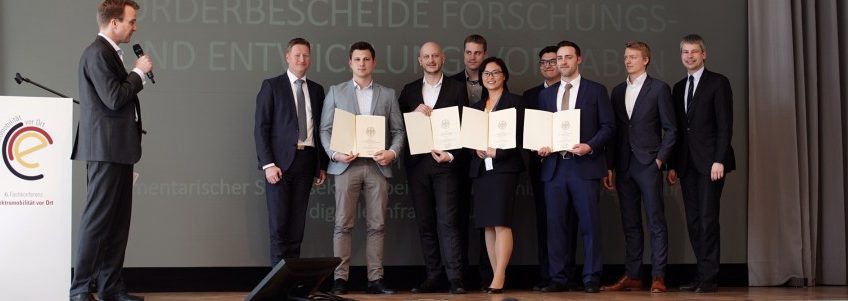Berlin/Stuttgart, 26 March 2019 – With an additional €6 million euros, the Federal Ministry of Transport and Digital Infrastructure (BMVI) is funding research and development projects in the area of electric mobility.
Steffen Bilger, Parliamentary State Secretary at the Federal Ministry of Transport and Digital Infrastructure, today presented the subsidy notes during the opening of the 6th conference on local electric mobility: “Elektromobilität vor Ort” in Stuttgart – the central forum nationwide for representatives from municipalities, municipal companies and transport companies as well as fleets and motor pools on the matter of cleaner mobility using batteries. The projects are funded within the BMVI’s electric mobility funding guideline. Aside from concept and investment support, their research and development content is an important element of supporting the further market ramp up of battery-electric vehicles. The R&D element, via the programme’s accompanying research, provides significant impetus for the further development of the funding programme.
The funded projects deal with local electric public transport, inner city commercial transport and the interaction of e-vehicle fleets and charging infrastructure. These are specifically:
MuLi
“Multimodal load module integration for different vehicle classes with a focus on e-buses”, funding amount: €1,321,892
- Consortium: Kölner Verkehrs-Betriebe Aktiengesellschaft, RheinEnergie AG, Ford-Werke GmbH
- Total amount: around 3.7m euros (research amount) + 1.4m euros (investment amount)
- Funding: around 1.3m euros (research amount) + 0.5m euros (investment amount within immediate action programme for clean air)
- Funding rate: average funding rate of around 35%
Project content and goals
The goal is to develop and test a charging system with integrated load modules for different vehicle classes, where the core system architecture is designed for recharging e-buses. To this end the load modules for the e-buses will be tested under real conditions during operation. At the same time the multimodal-designed charging system will be connected to different voltage levels (10 kV AC, rail DC), with a scalable storage solution also planned. For the first time a system will be implemented in the project, in which e-bus charging systems will be used for other vehicle categories, acting as mobility hubs. They will include an energy storage system and be connected to the traction current infrastructure of a municipal transport company.
Fleet transition (Flottenwende)
Funding amount: €845,876
- Consortium: StreetScooter GmbH, AixACCT Mechatronics GmbH, Wuppertal Institut für Klima, Umwelt, Energie gGmbH
- Total amount: around 1.8m euros
- Funding: around 0.85m euros
- Funding rate: average funding rate of around 60%
Project content and goals
In this project, based on typical requirement profiles for light commercial vehicles and charging concepts in municipal fleets, vehicle variants and needs-based charging facilities will be developed from the StreetScooter standard model, which has been tried and tested in practice. Up to 5 vehicle variants are planned to be developed. The prototypes will be made available free of charge to selected municipalities for a practical trial. Using the “StreetScooter approach”, the aim is to develop and test inexpensive e-commercial vehicles which are optimized according to their application context for different municipal deployment objectives.
E-Metrobus Berlin
“Electrification of metro bus lines with fast-charging infrastructure”, funding amount: €1,396,792
- Consortium: Berliner Verkehrsbetriebe (BVG), Technische Universität Berlin, Reiner Lemoine Institut gGmbH
- Total sum: around 1.7m euros (funding share) + 10.5m euros (investment share)
- Funding: around 1.4m euros (funding share) + 4.2m euros (investment share in the “Clean air” immediate action programme)
- Funding rate: average funding rate of around 82% (46 % resp.)
Project content and goals
The overarching goal of the project is the realization of robust, stable e-bus operation under the high load conditions of metro bus traffic in Berlin. Certain operational work objectives must be fulfilled here, e.g. the development and validation of robust operational concept and flexible disruption management for electrified metro bus lines, the analysis of the influence of interim charging on operational stability in highly-frequented metro bus transport, the evaluation of corrective measures and the expansion of competences in the area of planning and operation of electric bus transport. In the research area, the technical-scientific work objective is the testing and optimization of fast-charging infrastructure in the >300 kW output range, the design of the traction battery and examination of operation reserves required for operational disruptions. The strategic goals are the reduction of procurement costs for e-buses and charging infrastructure through high volumes, the positioning of Berlin as a pioneer in the transformation into emission-free and climate-neutral local transport, and the increase in visibility and acceptance of e-mobility.
I-rEzEPT
“Intelligent backfeeding electric vehicles for maximising own electricity consumption and participation in the primary operating reserve market”, funding amount: €2,391,517
- Consortium: Nissan Center Europe GmbH, Fraunhofer-Gesellschaft zur Förderung der angewandten Forschung e.V., Bosch Software Innovations GmbH
- Total amount: around 3.8m euros
- Funding: around 2.4m euros
- Funding rate: average funding rate of around 57%
Project content and goals
The central objective of the project is to reduce the cost disadvantage of electric vehicles over conventional ones. To this end new business models will be tested with the aim of reducing the investment and operational costs of electric vehicles and charging infrastructure. 20 e-vehicles and charging stations with backfeeding capability will be tested in the field, in order to be able to participate in the primary operating reserve market, maximise the degree of self-sufficiency of neighbourhoods and energy-efficient individual properties and engender sector-coupling between mobility, electricity and heat in an innovative and especially wide-ranging model.


